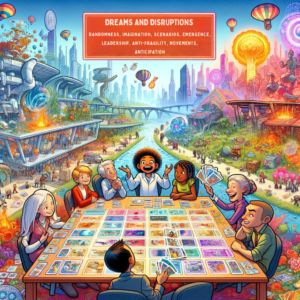
Beyond the Game: Exploring Future Worlds with Dreams and Disruptions

Reflecting on my keynote at this year’s RSD12 Relating Systemic Design Symposium (unfortunately, we failed to record the proceedings), I’m drawn back to the profound insights and experiences shared over the years through the Dreams and Disruptions Game. This imagination-based, scenario-building card game has transformed into a vital tool for some in exploring alternative future worlds. Since its inception in 2019, over 200 games have been played worldwide, illustrating that Dreams and Disruptions is more than just a game. It has evolved into a community that fosters a more imaginative, emergent, and surprise-focused approach to futures thinking.
The game has been played and occasionally brought together futurists, military personnels, scientists, communication experts, environmentalists, bankers, risk managers, community leaders, philosophers, academics, researchers, students, youth and various stakeholders. This eclectic mix of players has enriched the game with a multitude of perspectives, making each playthrough a unique exploration of games and possibilities. The game’s impact lies in its ability to harness the collective imagination of players, encouraging them to venture beyond the familiar terrains, reflect on to what never changes in the present and into the realms of what can be changed.
At the heart of Dreams and Disruptions is a dedication to fostering spaces where dynamic foresight and imagination can thrive. The game unfolds in three phases: building hybrid futures, crafting trajectories, and analyzing ways of knowing to transcend disruptions. Each phase challenges players to engage both critically and creatively, pushing the limits of their conceptual thinking. Players navigate through the game using prompt cards, which guide them in speculating about alternative future worlds and leadership archetypes. They encounter dilemmas demanding thoughtful decision-making and opportunities that ignite innovative ideas. This structure effectively transforms gameplay into a potent tool for envisioning emergent scenarios and strategic thinking.
The game concludes with an open conversation, a crucial phase where players reflect on their experiences and share insights. These discussions often revolve around scenario building, the influence of random emergence, the pivotal role of leaders and movements in changing the conditions of change, and the incorporation of planetary stressors in constructing hopeful, decolonized, and anti-fragile visions of tomorrows. Such conversations are not only intellectually stimulating but also emotionally resonant, as they often touch upon deep-seated contextual realities, fears and hopes about the future.
Moreover, Dreams and Disruptions champions the art of storytelling. By crafting and sharing narratives around speculative scenarios, players not only refine their communication skills but also engage others in the landscapes of their imagination. This aspect of the game is particularly impactful, as it underscores the power of narrative in shaping our understanding and perception of the future.
As I reflect on the journey of Dreams and Disruptions, I’m filled with a sense of radical hope. The game has become a platform for diverse voices to converge and co-create. It’s a testament to the power of collective imagination and the role it can play in shaping a future that is inclusive, diverse, innovative, resilient, and regenerative. The game’s success lies not just in the scenarios that the player could generate but, in the conversations, it has sparked and the minds it has opened. I would say that Dreams and Disruptions is more than a game; it’s a catalyst for change and for inspiring players to envision and work towards a future that is as bold, and imaginative as the game itself.

The integration of randomness, leadership and movement, emergence, stressors and scenario-building, Dreams and Disruptions Card Game offers a wealth of compelling insights.
Here are five key takeaways that emerge from this unique fusion:
- Enhanced Scenario Construction and Critical Thinking: The game encourages players to think in scenarios, a core aspect of foresight. By considering a variety of potential futures, players develop a more nuanced understanding of how different forces of change (from simple to complex and chaos) might interact and evolve. This process enhances critical thinking skills, as players must evaluate the feasibility and implications of each scenario. The game effectively turns abstract concepts into tangible, discussable elements, making the complex interplay of current and emerging trends more accessible and engaging.
- Collaborative Innovation and Co-Creation: Dreams and Disruptions fosters a collaborative environment where players co-create future scenarios. This aspect of the game mirrors the participatory nature of foresight, where diverse perspectives are essential for a comprehensive view of potential futures. By bringing together individuals with different backgrounds and expertise, the game stimulates innovative thinking and helps players to challenge their assumptions and biases. This collaborative process is vital in foresight, as it leads to more robust and inclusive future scenarios.
- Embracing Uncertainty and Complexity: Foresight is about embracing uncertainty and navigating complex futures. The game reflects this by presenting players with unpredictable situations and complex challenges. This experience teaches players to become more comfortable with uncertainty and to think flexibly about the future. Instead of seeking definitive answers, players learn to explore a range of possibilities and to adapt their thinking as new information emerges. This skill is crucial in real-world decision-making, where uncertainty is a constant and complexity is the norm.
- Developing Futures Literacy: The game serves as an effective tool for enhancing futures literacy, a key goal of foresight. Futures literacy is about understanding the dynamics that shape the future and being able to think constructively about what might happen. By engaging with the game, players become more adept at identifying emerging trends, understanding potential disruptions, and considering how various factors might influence future developments. This improved literacy empowers individuals to make more informed decisions and to participate more actively in shaping the future.
- Empowering Action and Agency: One of the most significant insights from embedding foresight with the game is the sense of agency it instills in players. The game’s interactive nature encourages players to think about how they can influence and shape the future, rather than seeing it as something that merely happens to them. This sense of empowerment is central to foresight, which aims not just to predict the future, but to inspire people to actively create it. By playing the game, individuals realize that they have a role in shaping futures and this realization can motivate real-world action and innovation.
The Dreams and Disruptions Card Game continually provides, and I hope others as well valuable lessons in scenario development, collaborative innovation, embracing complexity, futures literacy, empowerment, imagination, gamification, and personal agency. These insights are not only relevant for playing the game but also for navigating the uncertainties and opportunities of the real world.
